
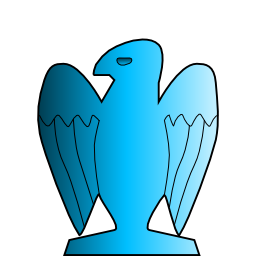
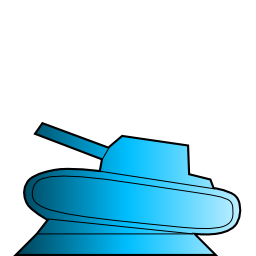
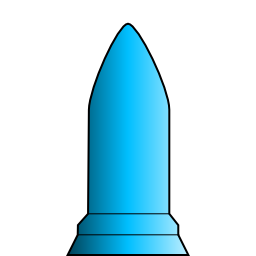
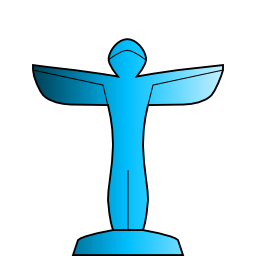
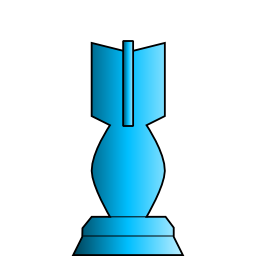
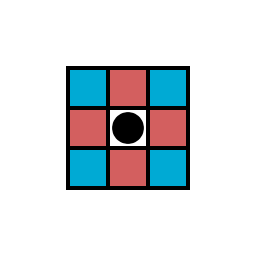
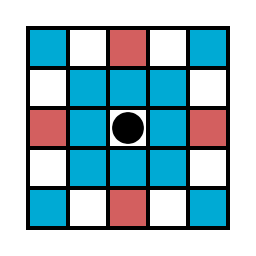
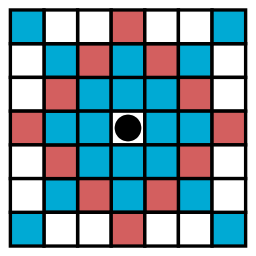
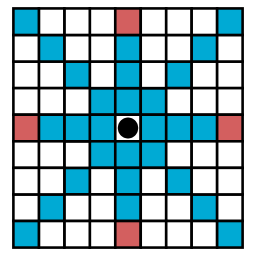
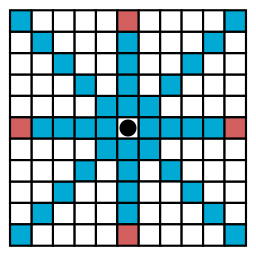

Wehrschach is a game similar to chess for two players, each controlling one of the parties "Blue" and "Red". Each party has 18 pieces of 6 types: 6 infantry pieces, 3 tanks, 2 fighter planes, 2 bomber planes, 4 artilleries and 1 main piece / headquarter. While looking differently fighters and bombers follow the same rules.
The game is played on an 11x11 grid which has two diagonally lines crossing it. The line from A1 to J11 is the mainroad which allows for faster movement. The line crossing from A11 to J1 is the river which blocks most movement. Each party has its own mainline which runs horizontally along the rows 3 and 9. They limit the movement of their headquarters (they can't enter the rows 4-8) and are important for one of the winning conditions (see below). There are two sea tiles at B5 and K7 which can't be entered by any unit.
Each piece has its own rules regarding movement and capturing of enemy pieces.
| Infantry | Headquarter | Tank | Artillery | Fighter Plane | Bomber Plane |
|---|---|---|---|---|---|
 |
 |
 |
 |
 |
 |
 |
 |
 |
 |
 |
 |
| The pieces can move to the red and blue tiles and capture/threaten enemy pieces that are on the red tiles. | |||||
Movement can always be done in eight directions: horizontally, vertically and diagonally.
While moving along the main road the infantry and tank may move up to four tiles. As mentioned earlier the headquarter may not enter the rows 4-8.
Only the planes are allowed to move over other pieces except over enemy planes and enemy artillery (which also represent AAA).
All pieces may move onto and across river tiles but never move along them (entering a river tile from another river tile) except of planes.
No piece may ever end its movement on a sea tile. Only planes are allowed to move across them.
Capturing a unit counts as a move and ends the players turn.
Capturing units can only be done horizontally or vertically (never diagonally except through enclosement, see below). Only the tank may capture through a "knight's move".
A piece can never capture an enemy piece alone. There always have to be two pieces which could capture the enemy piece for one of them to actually capture it. So without support it is not possible to capture any piece. To capture the piece one of the two (or more) threatening pieces takes the tile of the captured piece and the captured piece is removed from the game. Similar to movement capturing can not be done if the path is blocked by any pieces.
Pieces can only be captured/threatend if they have the correct distance to each other:
If an enemy piece gets enclosed by two of your pieces either horizontally, vertically or diagonally you can remove it during your turn. The piece gets removed, the enclosing pieces remain where they are and your turn ends. If multiple units are enclosed during your turn you can only remove one of them (or ignore all of them).
The headquarter is allowed to enclose enemies which are in the rows 4 or 8.

Planes may capture enemy pieces that are right next to them if the enemy piece is between the plane and one of your artilleries. The artillery has to be exactly four tiles away from the enemy piece and has to be placed so that all three tiles form a line with the plane being exactly five tiles away from the artillery.

The game can be won in multiple ways:
After reaching such a Judgement the other player has one move left to reach another Judgement to achieve a Draw. If the first Judgement was by moving five ground units beyond the enemy mainline the other player can cancel the Judgement and continue normal play if he manages to capture one of the five ground units.
If by taking the same turns over and over the same situations gets created three times the game counts as a Draw.

It is red's turn. Since his headquarter isn't endangered and he can't make a winning move he will attempt to protect his pieces. In this example only his tank in C2 is currently targeted by two enemy pieces: the tank on D4 which could get at it by either moving through C4 and C3 or by moving through D3 and then D2. The second piece is the plane at C7 which is exactly five tiles away and therefore at striking distance.
The easiest way to protect the tank would now be to just move it away. He could move it to C4 which would have multiple advantages. It wouldn't be endangered anymore, he would enclose the enemy tank on D4 together with his other tank on E4 and target the plane on C7.
Another option would be to move the artillery on A4 to C4 and thus blocking the plane on C7 from striking his tank as artillery blocks enemy planes. He would also enclose the enemy tank on D4. Other ways to block the plane would be to move the artillery on B6 or the plane on A1 or C2 in its path. Since the blue tank on D4 has two ways to reach his tank he can't block that by moving just one piece.
Instead of protecting the tank he could also ignore the threat and go on the offensive instead and capture the enemy plane on F6 with his artillery on B6 and his tank on E4. Since artilleries are not allowed to take the target's position he would have to move his tank to F6 and take the plane. But most likely he would loose his tank (C2) on the next turn.
"Copyright 2015 [Philippe Schober] This item is not authorized for posting on Steam, except under the Steam account named Fellhuhn"